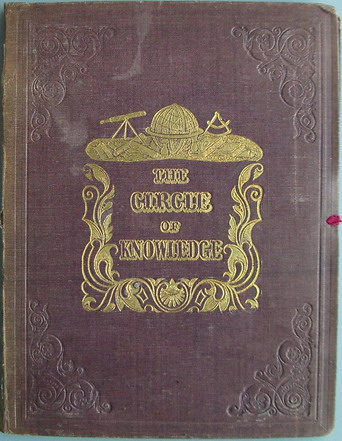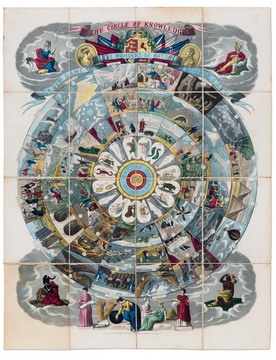Giochi dell'Oca e di percorso
(by Luigi Ciompi & Adrian Seville)
(by Luigi Ciompi & Adrian Seville)

|
Giochi dell'Oca e di percorso
(by Luigi Ciompi & Adrian Seville) |

|
 |

Torna alla ricerca giochi (back to game search) |
 |
| Circle (The) of Knowledge | ||
| A New Game of the Wonders of Nature Science & Art. | ||
 |
Versione stampabile
 |
Invia una segnalazione

|
  |
primo autore: | Anonimo |
| secondo autore: | Passmore John&Wallis Edward | |
| anno: | 1845 ca | |
| luogo: |
Inghilterra-Londra |
|
| periodo: | XIX secolo (2°/4) | |
| percorso: | Percorso di quattro cerchi concentrici | |
| materiale: | carta incollata su tela (engraving on paper with linen backing) | |
| dimensioni: | 629X509 | |
| stampa: | Litografia colorata a mano (hand-coloured engraving) | |
| luogo acquisto: | ||
| data acquisto: | ||
| dimensioni confezione: | 180X148 | |
| numero caselle: | 64 | |
| categoria: | Scienze naturali ed applicate | |
| tipo di gioco: | Gioco di percorso | |
| editore: | Published By J. Passmore, 18, Fleet Lane, Farringdon Street, London. | |
| stampatore: | Published by John Passmore 18 Fleet Lane | |
| proprietario: | Collezione E. C. | |
| autore delle foto: | E. C. | |
| numero di catalogo: | 1341 | |
| descrizione: |
Gioco di 64 caselle disposte su quattro cerchi concentrici ciascuno composto da sedici caselle. REGOLE: non riportate sul tavoliere. CASELLE: mute. REFERENZA 1 "Circle of Knowledge". (V&A Museum). The playing surface is divided into four concentric circles, three of which contain 16 pictures each. The inner ring illustrates the signs of the Zodiac and the four cardinal points of the compass. The 16 pictures of the outer ring each have a title, relating to two other pictures on the two inner rings. These are Europe, Asia, Africa and America; Earth, Air, Fire and Water; Electricity, Chemistry, Optics and Astronomy; Spring, Summer, Autumn and Winter. Some of the illustrations are quite unusual - fire, for example, is illustrated by a volcano, a burning farm and a pit explosion, and optics is represented by a giant telescope, a magic lantern show and the perspective through a tunnel. Physical description Design: engraving, coloured by hand; 16 sections mounted on linen; 64 pictures N°of squares: 64 Squares illustrated: all Square numbering: all Squares titled: see rules Subject of starting square: Europe Subject of ending square: ? Place of Origin: London Date: ca. 1845 Artist/maker: John Passmore Materials and Techniques: Hand-coloured engraving, mounted on linen Dimensions: Length: 62.9 cm; width: 50.9 cm. Cover: length: 18 cm; width: 14.8 cm. Object history note: No rules are available but it is possible that the game was played in a similar manner to the previous games published by E. Wallis and J. Passmore. Passmore was at the Fleet Lane address from about 1840 to 1869; in 1847 he took over Wallis's production. Historical context note Rewards: extra turns and forward movement and possibly receipt of counters. Forfeits: missing turns, staying in one place, backwards movement; possibly the payment of counters. N°of Players: any Equipment required: markers, counters. For spinning a teetotum or dice would be needed, however, as this is a Passmore game it is possible that a card with numbers and blanks together with the letters all to be cut up was provided as given in the previous couple of games. In that case the rules were probably similar. Rules: The playing sheet is divided into four concentric circles, three of which contain 16 pictures each. The inner ring illustrates the signs of the Zodiac and the four cardinal points of the compass. The sixteen pictures of the outer ring each have a title, which has a connection with the two other pictures of the two inner rings adjoining. These are: 1,17,33 Europe 5,21,37 Asia 9,25,41 Africa 13,29,45 America 2,18,34 Earth 6,22,38 Air 10,26,42 Fire 14,30,46 Water 3,19,35 Electricity 7,23,39 Chemistry 11,27,43 Optics 15,31,47 Astronomy 4,20,36 Spring 8,24,40 Summer 12,28,44 Autumn 16,32,48 Winter Examples of the pictures under these main headings are: SPRING 4. Dancing round a maypole 20. A Rainbow 36. Birds feeding their young AIR 6. A Balloon and a Parachute 22. A Shipwrecked Sailing Vessel 38. Windmill CHEMISTRY 7. Alchemist 23. Scientific Lecture 39. Interior of a chemist's shop FIRE 10. Volcano 26. Burning Farm 42 Pit Explosion and fire OPTICS 11. Giant Telescope 27. Perspective of a tunnel 43. Magic Lantern Show AUTUMN 12. Harvest Supper 28. Hop Picking 44. Pheasant Shooting Players would progress round the game on the spin of a teetotum or the selection of a numbered card. At each stop, they would be required to describe the events happening in the illustration and it is possible that forfeits and rewards would be given depending on each. It is possible to given forfeits and rewards to each squares and some are more obvious that others such as a fire or ship wreck go backwards or perhaps start again. *The illustrations are quite unusual - fire, for example, is illustrated by a volcano, a burning farm and a pit explosion, and optics is represented by a giant telescope, a magic lantern show and the perspective of a tunnel. Rules placement: possibly in booklet Descriptive line: Hand coloured educational race game, The Circle of Knowledge, published in England by John Passmore about 1845 REFERENZA 2 WHITEHOUSE, Francis Reginald Beaman, (pag. 40): CIRCLE OF KNOWLEDGE (The) A new game of the Wonders of Nature, Science and Art. Pubd. By J. Passmore, 18, Fleet Lane, Farringdon Street, London. A coloured lithograph size 20 in X 25 ½ in, mounted in 16 sections on linen, folded into hinged covers with title in gilt. The game comprises an 18 in track of 4 concentric circles of views, etc.: the inner ring contains the Signs of the Zodiac. At the head of the game sheet are the Royal Arms with portraits of Queen Victoria and Prince Albert on either side. Not dated. REFERENZA 3 "Circle of Knowledge (Le Cercle de la connaissance) édité vers 1845 par John Passmore couvre une grande varieté de sujets que l'on retrouve toutes les seize cases. Le jeu est fait de quatre cercles concentriques; trois contiennent chacun seize dessins et le cercle central figure les signes du zodiaque et les quatre points cardinaux. Par example, l'Europe est représentée sur les cases 1, 17 et 33, alors que l'Asie se trouve sur les cases 5, 21 et 37. L'Afrique et l'Amerique sont aussi représentées, ainsi que les quatre saisons, les quatre maisons du zodiaque et les quatre sciences- l'électricité, la chimie, l'optique et l'astronomie. Les illustrations sont assez inhabituelles- le feu, par example est représenté par un volcan, une ferme en feu et l'explosion d'un cratère, et l'optique est représenté par un télescope géant, un spectacle de lanternes magiques et un tunnel en perspective". (GOODFELLOW Caroline) REFERENZA 4 "Covering a wide range of subjects which are arranged in a pattern of three compartments every 16th place, is the Circle of Knowledge, published in about 1845 by John Passmore. The game is laid out in four concentric circles; three contain 16 pictures and the inner ring shows the signs of the zodiac and the four cardinal points of the compass. For example, europe is illustrated in compartments 1, 17 and 33 while Asia is shown in 5, 21 and 37. Asia and America are also shown, as are the four seasons, the four sciences- electricity, chemistry, optics and astronomy. The illustrations are quite unusual - fire, for instance, is illustrated by a volcano, a burning farm and a pit explosion, and optics is represented by a giant telescope, a magic lantern show and the perspective of a tunnel." (GOODFELLOW Caroline) REFERENZA 5 "The Circle of Knowledge, a New Game of the Wonders of Nature, Science & Art", London: John Passmore, ca. 1850, 51 x 65 cm. (Yale University GV1199 .C57 1850). HOW TO PLAY THE GAME: The rings of the game are named for the continents, the seasons, the four elements (air, fire, earth, water), and for chemistry, optics, astronomy, and electricity. A player needed to answer questions hat correspond to the numbered spaces in order to end up in the Circle of Knowledge in the center. (Patrons) Exhibitions: - "Instruction and Delight: Children's Games from the Ellen and Arthur Liman Collection" (Yale Center for British Art, 17 January-23 May, 2019). |
|
| bibliografia: |
1) WHITEHAUSE, F.R.B.: "Table Games of Georgian and Victorian Days", London, Peter Garnett, 1951. 2) GOODFELLOW, Caroline: "A Collector's Guide to Games and Puzzles". Secaucus, New Jersey, Chartwell Books-London, Quintet Publishing Limited 1991. 3) GOODFELLOW, Caroline: "The Development of the English Board Game, 1770-1850", in Board Games Studies 1, 1998. 4) GOODFELLOW, Caroline: "Jeux de société. Le guide du collectionneur des jeux de société depuis le XVIIIe siècle jusqu’à nos jours", (Edizione francese) Carrousel MS, 2001. 5) SEVILLE, Adrian: "The Game of Goose: and its influence on cartographical race games" Journal of the International Map Collectors' Society, Winter 2008 N°115 2008. 6) SEVILLE, Adrian: "The geographical Jeux de l'Oie of Europe." In "Belgeo" 2008 3-4 2008. 7) GOODFELLOW, Caroline: "How We Played: Games From Childhood Past", History Press, 2012. 8) QUINN, Brian - CARTWRIGHT, William: "Geographic Board Games". Geospatial Science Research 3. School of Mathematical and Geospatial Science, RMIT University, Australia. December 2014. 9) SEVILLE, Adrian: "The Royal Game of the Goose four hundred years of printed Board Games". Catalogue of an Exhibition at the Grolier Club, February 23 - May 14, 2016. 10) LIMAN, Ellen: "Georgian and Victorian Board Games: The Liman Collection", Pointed Leaf Press, 2017. 11) NORCIA, Megan A.: "Gaming Empire in Children's British Board Games, 1836-1860". Studies in Childhood, 1700 to the Present. Routledge, 2019. 12) SEVILLE, Adrian: "L'arte dei giochi da tavolo. Oltre un secolo di storia e divertimento dalla fine del Settecento all'inizio del Novecento." Edizioni White Star, 2019. 13) PARLAK, Omer Fatih: "Seafearing through the Perspective of Historic Board Games", in DGSM, Köllen Druck+Verlag, Bonn 2020. |
|
| "The Development of the English Board Game, 1770-1850" (Caroline G. Goodfellow) | ||
| Instructional Games. "Table Games of Georgian and Victorian Days". (Francis Reginald Beaman, Whitehause) | ||
Vai alla ricerca giochi Vai all'elenco autori